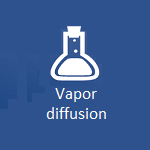![[ Polski ]](../../images/POLA001.gif)
![[ Deutsch ]](../../images/GERM001.gif) EN ISO 10211:2007 and 10077-2:2003 Conformance of AnTherm
EN ISO 10211:2007 and 10077-2:2003 Conformance of AnTherm
The software is validated conform all 4 cases of ISO 10211:2007, Annex A, for three-dimensional calculation programs.
The software is validated conform all the ten cases of ISO 10077:2003, Annex D.
High precision calculation methods for thermal bridges according to EN ISO 10211:2007
The EN ISO 10211 "Thermal bridges in building construction — Heat flows and surface temperatures — Detailed calculations" in its appendix A provides the validation procedure by which a "thermal bridges program" must conform to, to be qualified as "high precision method". The application package AnTherm conforms in its current version to all respective criteria specified by EN ISO 10211:2007 for "high precision calculation methods" and thus it qualifies as "two- and three-dimensional steady-state high precision method (class A method)"
Documentation: Details of validation results are put together the calculation report of validation examples from the EN ISO 10211:2007 by the application package Antherm (PDF file) ![]() . The separate extensive appendix contains the Input and evaluation reports of all four reference cases (PDF file). Click here to download AnTherm project files of all test cases in the validation EN ISO 10211:2007 (ZIP/antherm)
. The separate extensive appendix contains the Input and evaluation reports of all four reference cases (PDF file). Click here to download AnTherm project files of all test cases in the validation EN ISO 10211:2007 (ZIP/antherm)
| Reference case 1 (two-dimensional; temperature distribution within "half of a square column") By the precision set within the standard (1 decimal place after comma) AnTherm provides exactly concordant results. By concerning uncertainties resulting from rounding there is full concordance of results calculated by AnTherm with values calculated analytically. |
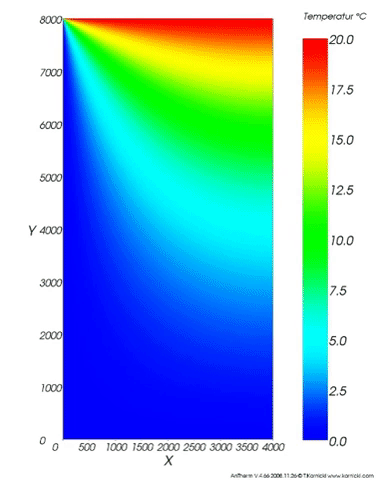 |
| Reference case 2 (two-dimensional; temperature distribution and heat flow within a roof construction) This reference is considered shaky due to the temperature and heat flow calculation requirement within the junction made of a aluminum bracket nested within insulating material. By concerning uncertainties resulting from rounding there is full concordance of results calculated by AnTherm with values set in EN ISO 10211:2007. | 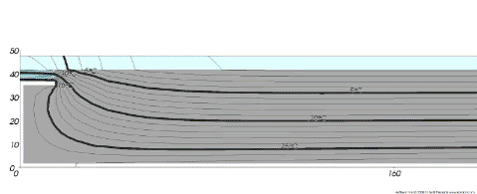 |
| Reference case 3 (three-dimensional; temperature distribution and heat flows through the wall-balcony junction) By concerning uncertainties resulting from rounding there is full concordance of results calculated by AnTherm with values set in EN ISO 10211:2007. The difference between heat losses of interior spaces α and β and gains of the exterior (space α) calculated by AnTherm and those specified by EN ISO 10211:2007 are smaller than 0.11 %. The requirement set in EN ISO 10211, that differences of calculated heat flow values must not exceed 1%, is met by AnTherm in full. |
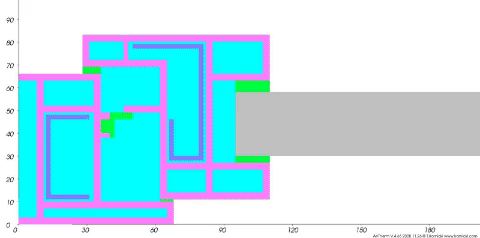 |
| Reference case 4 (three-dimensional; temperature distribution and heat flows within a three dimensional thermal bridge consisting of an iron bar penetrating an insulation layer) By concerning uncertainties resulting from rounding there is full concordance of results calculated by AnTherm with values set in EN ISO 10211:2007 The difference of 0.43% between the calculated heat flow and the value set by the standard is below the allowed tolerance of 1% as required by the reference case; The temperature calculated at the hottest point at exterior surface deviates by 0.003K which is below the tolerance of 0.005K set by the standard for that reference case; the criteria are met in full by AnTherm. | 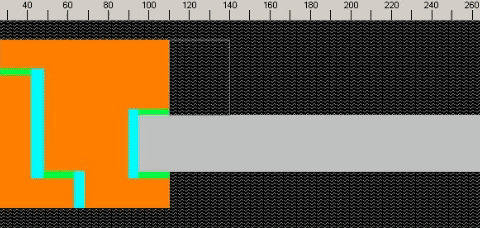 |
We proudly present the conformance statement on validation of the program AnTherm acoording to EN ISO 10211:2007 from Prof. Dipl. Ing. Dr. techn. Klaus Kreč showing that program AnTherm obey the rules to the full extent.
Archive: The information about the validation of the program for conformance to the earlier European standard EN ISO 10211-1:1996 are available for your reference.
Numerical standard method for frames of windows, doors and shutters according to EN ISO 10077-2:2003
The EN ISO 10077-2:2003 "Thermal performance of windows, doors and shutters - Calculation of thermal transmittance - Part 2: Numerical method for frames" in its appendix D provides the validation procedure by which a "thermal bridges program" must conform to, to be qualified as sufficient for the calculation of heat flow through frames conformant to the standards. The application package AnTherm conforms in its current version to all respective criteria and assessments specified by EN ISO 10077-2:2003 and thus it can be used as "standard method for calculation of heat flow through frames of windows, doors and shutters"
Detailed validation results are put collectively into the calculation report of validation examples from the EN ISO 10077-2:2003 with the application package Antherm (PDF file) ![]() . The separate extensive appendix contains the Input and evaluation reports of all ten reference cases (PDF file). Click here to download AnTherm project files of all test cases in the validation EN ISO 10077:2003 (ZIP/antherm).
. The separate extensive appendix contains the Input and evaluation reports of all ten reference cases (PDF file). Click here to download AnTherm project files of all test cases in the validation EN ISO 10077:2003 (ZIP/antherm).
Reference cases 1 through 7 (thermal conductance Lf2D and thermal transmittance Uf of frame profiles)
By concerning uncertainties resulting from rounding there is full concordance of results calculated by AnTherm with values set in EN ISO 10077-2:2003.
The differences between thermal conductance Lf2D calculated by AnTherm to those specified in the EN ISO 10077:2003 stay below 1.1%. The requirement set in EN ISO 10077-2, that differences of calculated thermal conductance must not exceed 3.0%, is met by AnTherm in full.
The differences between thermal transmittance Uf calculated by AnTherm to those specified in the EN ISO 10077:2003 stay below 1.7%. The requirement set in EN ISO 10077-2, that differences of calculated thermal transmittance must not exceed 5.0%, is met by AnTherm in full.


Reference cases 8 and 9 (thermal conductance Lf2D and transmittance U of profiles)
By concerning uncertainties resulting from rounding there is full concordance of results calculated by AnTherm with values set in EN ISO 10077-2:2003.
The differences between thermal conductance Lf2D calculated by AnTherm to those specified in the EN ISO 10077:2003 stay below 1.2%. The requirement set in EN ISO 10077-2, that differences of calculated thermal conductance must not exceed 3.0%, is met by AnTherm in full.
The differences between thermal transmittance U calculated by AnTherm to those specified in the EN ISO 10077:2003 stay below 0.5%. The requirement set in EN ISO 10077-2, that differences of calculated thermal transmittance must not exceed 5.0%, is met by AnTherm in full.



Reference case 10 (thermal conductance Lf2D and linear thermal transmittance Ψ of glazing, spacer and frame compound)
By concerning uncertainties resulting from rounding there is full concordance of results calculated by AnTherm with values set in EN ISO 10077-2:2003.
The difference between the thermal conductance Lf2D calculated by AnTherm to the value specified in the EN ISO 10077:2003 stays below 0.2%. The requirement set in EN ISO 10077-2, that differences of calculated thermal conductance must not exceed 3.0%, is met by AnTherm in full.
The difference between the linear thermal transmittance Ψ calculated by AnTherm to the value specified in the EN ISO 10077:2003 stays below 2.4%. The requirement set in EN ISO 10077-2, that difference of calculated linear thermal transmittance must not exceed 5.0%, is met by AnTherm in full.
Interested?
Contact
us for more information.
Or try and evaluate the demonstrational version just now!









